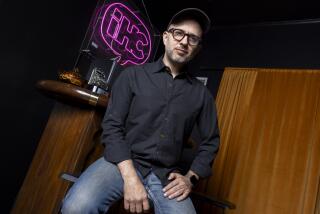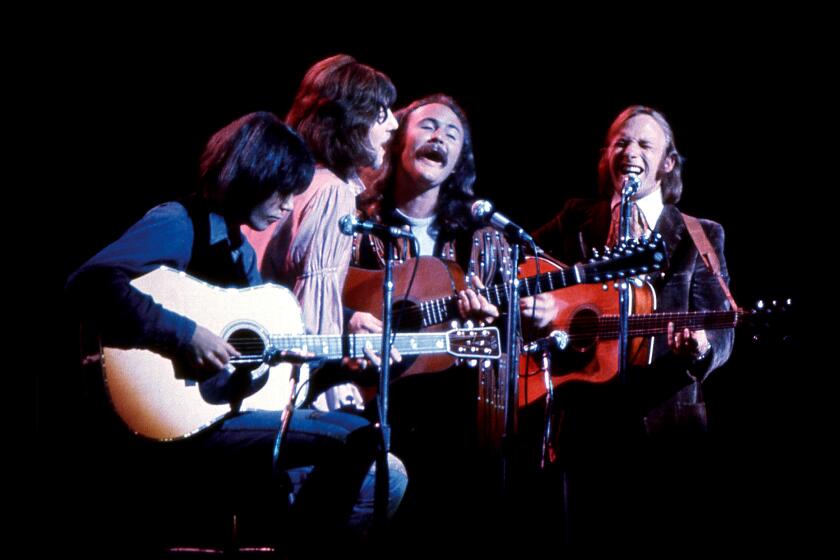THE L.A. CLUBS--WHERE IS THY ZING?
- Share via
Here’s one opinion on the current Los Angeles music scene: “The club scene is vital. I think it’s going to be good this year.”
And a different view: “The music scene’s in something of a doldrums now. The whole mood in L.A. is, ‘So what?’ ”
The funny thing is, both statements were made by the same person: Beachy, who books the shows at the Music Machine on Pico Boulevard in West Los Angeles.
It’s not just Beachy who carries this mixed message. Booking agents at some of the area’s leading clubs agree that while there are lots of good acts playing the clubs and plenty of club patrons to support them, the climate lacks some zing.
That’s quite a contrast to a few years ago when Southland clubs were a hotbed of new American music, nurturing challenging bands--the Go-Go’s, X, Dream Syndicate, Lone Justice--that went on to artistic and/or commercial success.
But where these bands were supported and spurred by a diverse, demanding audience, today’s scene sports several distinct audiences, each one following a particular kind of music.
While there’s nothing wrong with performers playing before their audiences and club patrons sticking with their music, it’s not an environment that fosters vitality: Neither performers nor fans receive the stimulation that comes with facing new sounds and new listeners.
The Music Machine’s Beachy (he uses no last name), who has experienced the club scene as a musician as well as a club booker, recalls that the heyday for L.A. clubs started when the Whisky and the Starwood were the only major rooms. It may have been tougher for bands to survive, he said, but it was much more exciting.
“Bands that came up through that era have a different mentality than those in the last couple years,” he says.
The Anticlub’s Jim Van Tyne, who says his operation on Melrose Avenue is “about music that’s a challenge,” has been feeling frustrated lately. “There aren’t the adventurous bands that there were a couple years ago. There is vitality, it’s just gotten safer. We end up having a lot of the same bands each month. I have to admit that sometimes I have a hard time remembering who’s playing that night.”
But the scene may look worse from the inside than it actually is. Certainly business is good, so somebody’s doing something right.
“There is exciting music out there locally,” insists Brendan Mullen, whose Lingerie club on Sunset Boulevard is having more trouble with the fire marshal over capacity than with presenting good music.
“It’s just that local audiences are overexposed to it and tend to take it for granted. I had some friends that came in from New York and they thought L.A. was much more vibrant than New York.”
The most dramatic evidence of audience fragmentation is provided by the Palomino. Though the North Hollywood landmark remains a mecca for country musicians and fans, the club has been offering more variety than before--a recent schedule shows rock, pop, R&B; and Latin acts as well as country. This policy is continuing after the recent death of club founder Tommy Thomas, as his wife Sherry and nephew Billy Thomas now share the booking duties.
“Over the years we’ve gone to a broader spectrum of entertainment,” said Billy Thomas, who says he “grew up in this place,” learning the business from his uncle and his late father, Tommy’s brother Bill. He admitted that the changes have made the club less distinctive. “We used to have a tremendous following of regulars when we were just country. But now that we’re more diversified I see different crowds with different bands.”
Are those old regulars put off by the changes?
“I still find people who think it’s a country nightclub,” he said. “I’ve seen some cowboys come in and see an R&B; act, say ‘What’s that?’ and walk out.”
Other clubs, too, have seen a decline in regular patrons.
“There’s not much hanging out,” said the Lingerie’s Mullen. “There are still people that go, ‘Hey, let’s go to the Lingerie,’ but a couple of years ago it would fill up automatically, just people going to the club. Now it’s more determined by the act, not just people who go to socialize.”
The 200-capacity Anticlub, an arty alternative to the mainstream clubs, has also witnessed this change.
“It’s a real mishmash,” said Van Tyne, who has run the club for the past two years with partners Russell Jessum and Jack Marquette. “It (the audience) changes every night. There’s a certain core group that we always see, though last night the place was packed and I didn’t know anyone there.”
“In 1956, there was Elvis and black music breaking to white audiences,” Mullen recounted. “In ‘66, there was the rise of flower power and psychedelia; in ‘76, the rise of punk. Here we are in 1986 and we better be ready.”
But the L.A. club bookers aren’t sure what it will be. Van Tyne sounded disappointed as he said that he doesn’t see any exciting trends on the horizon.
“I wish I did. I think there’s a certain longing, waiting for things to happen.”
“It’s 1986 and it’s time to wake up!” shouted Mullen, whose Masque club in Hollywood in the late ‘70s was the springboard for the fertile L.A. scene. “Whenever something comes from left field, it’s never been something that could be predicted.”
Said Beachy, formerly with frat-rockers Beachy & the Beachnuts, “Musically, I see a trend heading back to basics--guitar, bass and drums--and getting away from the English disco bands and regimented sound.”
(Local club bookers make their picks to click on Page 68.)
One perennially popular sound that is not being heard much in these clubs is hard rock. Even though many predict that its glitter/glam wing could be the next major commercial force, it’s not considered particularly good fare for the clubs. The reason is clear: the age of its fans.
“It seems that in California all entertainment is predicated on the sales of alcoholic beverages,” Mullen said. Small clubs whose survival depends on those sales can’t afford to program for under-age crowds. The Lingerie and Music Machine, with legal capacities of 375 and 205, respectively, both enforce age limits of 21.
Even the 600-seat Palomino, by far the largest of the four clubs, doesn’t welcome youthful hard-rock crowds.
“When we have a young crowd, the liquor store across the parking lot does better than we do,” Thomas said. “We’ve never done well with hard rock. I don’t like the clientele. The Palomino has always been a place where if you were 60 years old you could have as much fun as a 15-year-old.”
Says Beachy, “It’s too much trouble to deal with underage (fans). They’ll inevitably drink.”
Hard rock, though, is less of a problem for Beachy, who works a lot of it into the Music Machine schedule.
“There’s a broad audience for that,” he maintains. “The people are for the most part in their mid-20s, bands and fans.”
Mullen noted that having to keep younger crowds out of the clubs could spell long-range trouble, especially if the scene doesn’t emerge from its slump soon.
What is being left outside is not just a bunch of kids, he said, but “the next generation that would be jazzed to go out.”
The younger set, he’s afraid, may never get into the club habit.
“There’s nowhere for them to go, so I suppose they stay at home with their VCRs or roam the streets.”
More to Read
The biggest entertainment stories
Get our big stories about Hollywood, film, television, music, arts, culture and more right in your inbox as soon as they publish.
You may occasionally receive promotional content from the Los Angeles Times.










